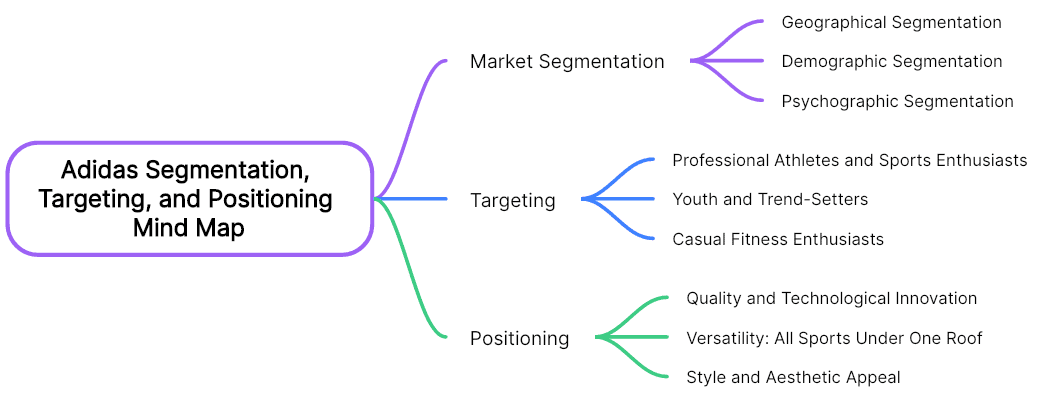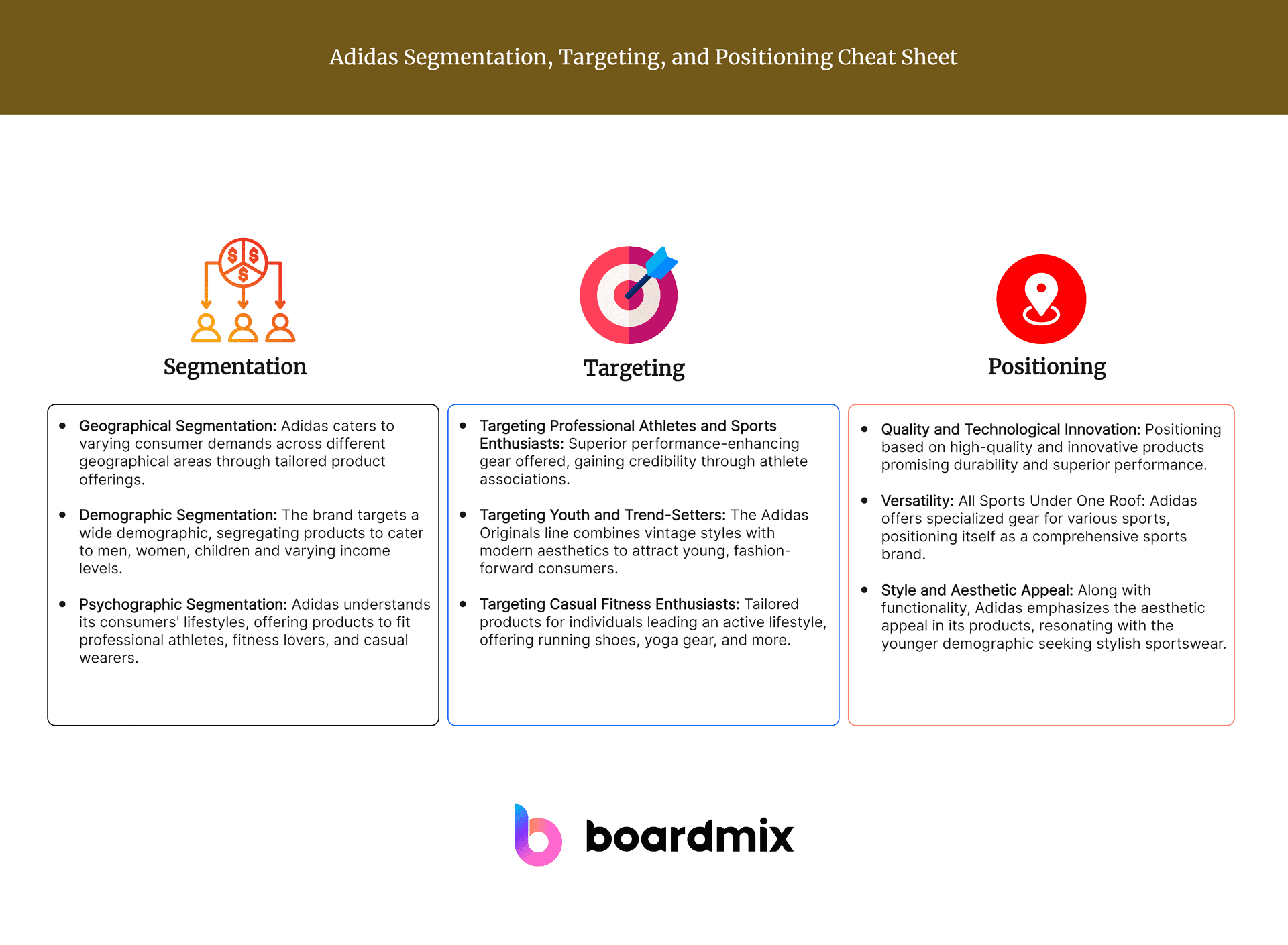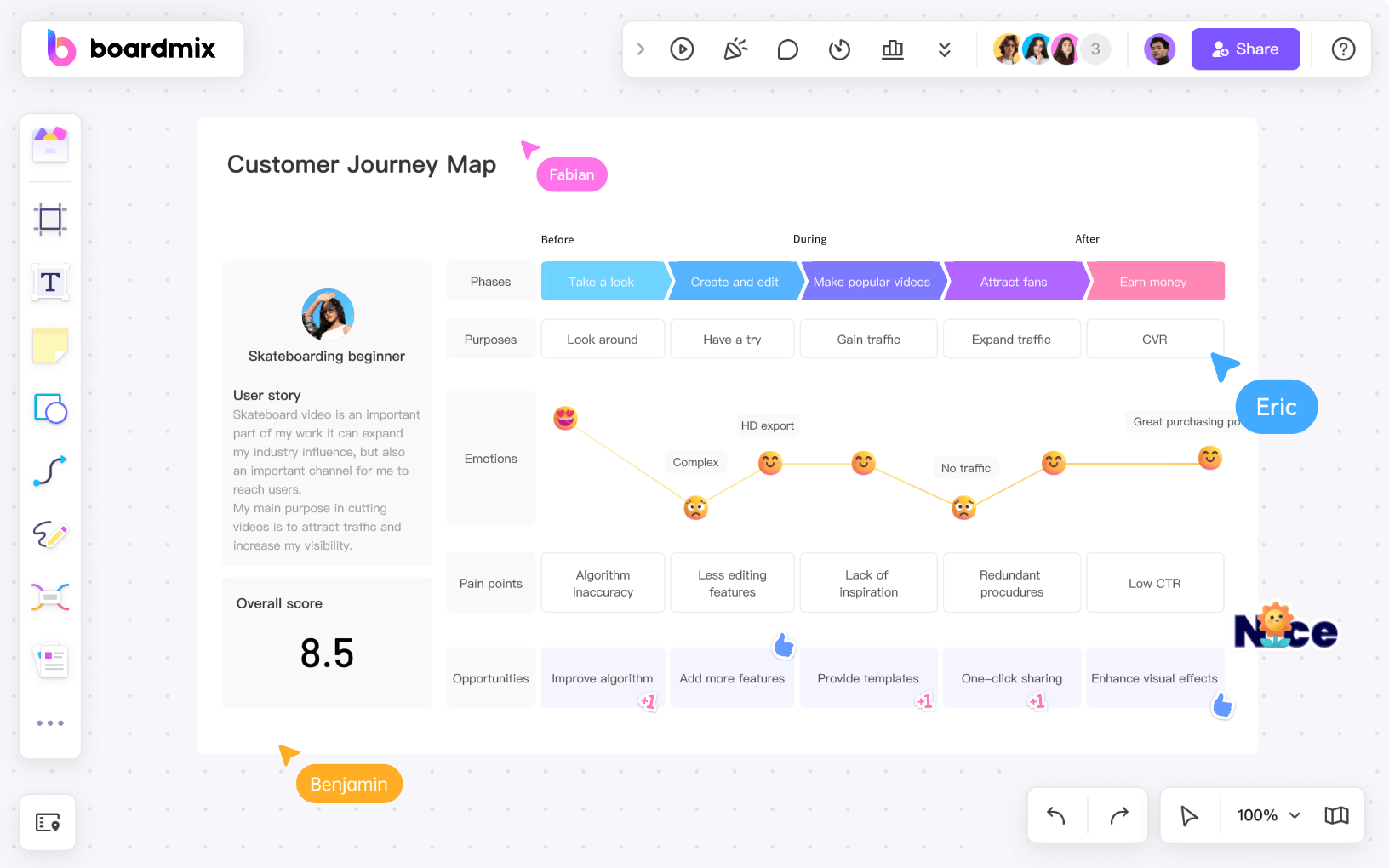In the high-octane world of sports apparel, one name resonates with athletes and casual wearers alike: Adidas. The German-born company has proven its mettle in the global market through strategic segmentation, pinpoint targeting, and compelling positioning.
As you dive into this article, imagine it as a roadmap, an intricate Adidas Segmentation, Targeting, and Positioning Mind Map, guiding you through Adidas's strategy.

Market Segmentation of Adidas
The magic behind the success of Adidas is rooted in its highly effective market segmentation. To ensure that their products resonate with their diverse consumer base, the brand has divided its vast market into segments, classifying them based on geographical areas, demography, and psychography.
Let's delve deeper into each category:
Geographical Segmentation
Adidas operates on a global scale, with markets scattered across Europe, North America, Asia-Pacific, and Latin America. However, its approach is far from generic. Each regional market has unique preferences and demands that Adidas tactfully addresses through its product offerings. For instance, its lightweight shoes and cooling apparels are popular in warmer regions, while their range of insulated sportswear takes precedence in colder climates.
Demographic Segmentation
When it comes to demographic segmentation, Adidas leaves no stone unturned. The brand appeals to a broad age group, ranging from kids in their playful childhood to adults leading active lives. Gender-specific offerings are also an integral part of Adidas’s demographic strategy. Their product line is effectively segregated to cater to the specific needs of men, women, and children.
Moreover, Adidas acknowledges income variations among its customers by offering a range of products at different price points – high-quality essentials for budget shoppers and high-end limited editions for luxury seekers.
Psychographic Segmentation
In the realm of psychographic segmentation, Adidas demonstrates a keen understanding of its consumers' lifestyle and behavioral patterns. The brand recognizes that its customer base is not limited to professional athletes alone but extends to fitness enthusiasts and casual wearers.
Thus, Adidas has developed an extensive product portfolio that encompasses different sports and physical activities. From basketball shoes to running spikes, tennis rackets to yoga mats – there's something for everyone.
The beauty of Adidas's psychographic segmentation lies in the creation of products that enhance performance while embedding style and comfort. This blend has successfully catered to the preferences of professional athletes, fitness lovers, and people leading an active lifestyle, ensuring a sustained brand loyalty.
Targeting of Adidas
Adidas's smart targeting strategy is the linchpin holding its vast consumer base together. Known for its multi-segment approach, Adidas targets its demographic segments accurately, each defined by unique traits and preferences. Let's probe further into their ingenious targeting:
Targeting Professional Athletes and Sports Enthusiasts
Adidas caters primarily to professional athletes and sports enthusiasts. Their products are built with superior technology designed to enhance performance and offer comfort during strenuous physical activities. By associating their brand with globally celebrated athletes, they further validate their credibility in the eyes of this target segment.
Targeting Youth and Trend-Setters
One cannot overlook the immense popularity of Adidas among the young, fashion-forward population. Their Adidas Originals line reimagines sports gear into street fashion, effectively resonating with youth and trendsetters. This line's vintage styles combined with modern aesthetics are designed specifically to align with the dynamic, ever-evolving fashion preferences of this age group.
Targeting Casual Fitness Enthusiasts
A significant part of Adidas's targeting strategy involves casual fitness enthusiasts – individuals who might not be professional athletes but uphold an active lifestyle. For them, Adidas offers products like running shoes, yoga gear, and fitness equipment, specifically designed to cater to different kinds of workout regimes.
Positioning of Adidas
Positioning is the art of creating a distinct place in the consumer's mind for the brand, and Adidas has mastered this art. Its positioning strategy focuses on two main elements: quality products and a blend of style with functionality. Let's dissect this:
Quality and Technological Innovation
Adidas has positioned itself as a purveyor of quality sports gear. Their products are designed using cutting-edge technology that promises durability and superior performance. For example, the Boost technology in their shoes provides optimum energy return with every stride, providing athletes with increased speed and performance.
The continuous introduction of such innovative technologies affirms Adidas's commitment to quality, setting a high benchmark in the sports apparel industry.
Versatility: All Sports Under One Roof
Adidas has established itself as an all-encompassing sports brand offering products catering to a plethora of sports. Be it football, basketball, tennis, running or even golf; Adidas offers specialized gear for all, hence positioning itself as a one-stop destination for sports-related products. This versatility appeals to a wide range of sports enthusiasts, reinforcing their positioning strategy.
Style and Aesthetic Appeal
Positioning isn't merely about functionality; aesthetic appeal also plays a crucial role, and Adidas comprehends this well. They seamlessly blend style with functionality, creating products that aren’t just performance-driven but also fashion-forward. The Adidas Originals line serves as the perfect testament to this. This strategy appeals to the younger demographic that seeks both comfort and style in their sportswear.
Adidas Segmentation, Targeting, and Positioning Cheat Sheet
Consider this cheat sheet a compact overview of what we’ve been discussing. It neatly presents the Adidas STP strategy - an epitome of meticulous market research and strategic execution. With this guide in your arsenal, you’ll have a handy reference whenever you need a refresher on this remarkable case study.

Key Takeaways: Making Brand Positioning Analysis on Boardmix
So what have we learned? In essence, the Adidas STP strategy is a testament to the brand’s understanding of its consumer base and its dedication to serving them optimally. Adidas exemplifies how successful segmentation, accurate targeting, and effective positioning can elevate a brand to unprecedented heights. Adidas's enduring success isn’t simply a stroke of luck; it’s a product of a well-thought-out STP strategy, a testament to the power of understanding your market and positioning your brand effectively within it.
Ready to map out your own segmentation or position your business effectively like Adidas? We recommend trying out our solution Boardmix. Using our pre-built Market Segmentation Template and STP Analysis Template can guide you through the process with ease.
Understanding your brand's unique position in the market can give your business a competitive edge. Boardmix is an excellent tool for conducting a brand positioning analysis, providing various benefits.

1. Structured Analysis
With Boardmix, you can use or create custom templates for your brand positioning analysis. These templates can guide you through the process, ensuring that all vital factors - such as Unique Selling Proposition (USP), target audience, brand values, brand personality, and key differentiators - are thoroughly addressed.
2. Collaboration
Brand positioning analysis often requires insights from various team members - from marketing to product development. Boardmix's collaboration features make it easy to involve your entire team in the process, facilitating an exchange of ideas and perspectives that can enrich your analysis.
3. Accessibility
With Boardmix, your brand positioning analysis is not just a static document. It's a dynamic resource that's accessible to your team members anytime, anywhere. This makes it easier to keep everyone aligned on your brand's positioning and strategic direction.
4. Iterative Refinement
The market is constantly evolving, and so should your brand positioning. Boardmix makes it easy to update your analysis as your brand grows and the market changes. You can easily add new insights, adjust your strategies, and keep your team informed about these changes.
5. Integrated Feedback
The platform allows stakeholders to provide their feedback directly on the analysis. This integrated feedback system streamlines communication and makes it easier to refine your brand positioning based on valuable input.
6. Historical Reference
Your previous brand positioning analyses on Boardmix can serve as valuable historical references. Comparing your current positioning with past strategies can offer insights into how your brand has evolved.
By facilitating collaboration, structuring analysis, and offering flexibility, Boardmix is a beneficial tool for any company looking to deepen its understanding of its brand positioning.













